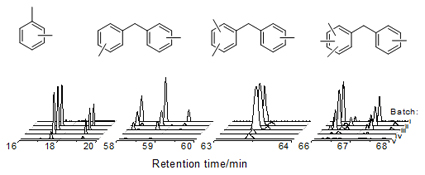| [1] Tsai, T.-C.; Liu, S.-B.; Wang, I. Appl. Catal. A 1999, 181, 355.
[2] Xu, O.; Su, H.; Ji, J.; Jin, X.; Chu, J. Chin. J. Chem. Eng. 2007, 15, 326.
[3] Tukur, N. M.; Al-Khattaf, S. Energy Fuels 2007, 21, 2499.
[4] Chen, Q. L.; Kong, D. J.; Yang, W. S. Petrochem. Technol. 2004, 33, 909.(陈庆龄, 孔德金, 杨卫胜, 石油化工, 2004, 33, 909.)
[5] Hamedi, N.; Iranshahi, D.; Rahimpour, M. R.; Raeissi, S.; Rajaei, H. J. Taiwan Inst. Chem. Eng. 2015, 48, 56.
[6] Ali, S. A.; Ogunronbi, K. E.; Al-Khattaf, S. S. Chem. Eng. Res. Des. 2013, 91, 2601.
[7] Ali, S. A.; Aitani, A. M.; Ercan, C.; Wang, Y.; Al-Khattaf, S. Chem. Eng. Res. Des. 2011, 89, 2125.
[8] Tsai, T.-C.; Liu, S.-B.; Wang, I. Catal. Surv. Asia 2009, 13, 94.
[9] ?ejka, J.; Wichterlová, B. Catal. Rev.: Sci. Eng. 2002, 44, 375.
[10] Chen, N. Y.; Degnan, T. F. Chem. Eng. Prog. 1988, 84, 32.
[11] Lee, Y.-K.; Park, S.-H.; Rhee, H.-K. Catal. Today 1998, 44, 223.
[12] Chao, K.-J.; Leu, L.-J. Zeolites 1989, 9, 193.
[13] Krej?í, A.; Al-Khattaf, S.; Ali, M. A.; Bejblová, M.; ?ejka, J. Appl. Catal., A 2010, 377, 99.
[14] Yue, Y. H.; Tang, Y.; Kan, Y. Z.; Gao, Z. Acta Chim. Sinica 1996, 54, 591.(乐英红, 唐颐, 阚勇志, 高滋, 化学学报, 1996, 54, 591.)
[15] Meshram, N. R.; Kulkarni, S. B.; Ratnasamy, P. J. Chem. Technol. Biotechnol., Chem. Technol. 1984, 34, 119.
[16] Ji, Y. J.; Zhang, B.; Zhang, K.; Xu, L.; Peng, H. G.; Wu, P. 1980, 38, 191.(纪永军, 张斌, 张坤, 徐乐, 彭洪根, 吴鹏, 化学学报, 1980, 38, 191.)
[17] Higgins, J. B.; LaPierre, R. B.; Schlenker, J. L.; Rohrman, A. C.; Wood, J. D.; Kerr, G. T.; Rohrbaugh, W. J. Zeolites 1988, 8, 446.
[18] Hegde, S. G.; Kumar, R.; Bhat, R. N.; Ratnasamy, P. Zeolites 1989, 9, 231.
[19] Wang, I.; Tsai, T. C.; Huang, S. T. Ind. Eng. Chem. Res. 1990, 29, 2005.
[20] Dumitriu, E.; Hulea, V.; Kaliaguine, S.; Huang, M. M. Appl. Catal., A 1996, 135, 57.
[21] Corma, A.; Llopis, F.; Monton, J. B. J. Catal. 1993, 140, 384.
[22] Al-Khattaf, S.; Ali, S. A.; Aitani, A. M.; Zilkova, N.; Kubicka, D.; Cejka, J. Catal. Rev.: Sci. Eng. 2014, 56, 333.
[23] Corma, A.; Sastre, E. J. Catal. 1991, 129, 177.
[24] Xiong, Y.; Rodewald, P. G.; Chang, C. D. J. Am. Chem. Soc. 1995, 117, 9427.
[25] Svelle, S.; Olsbye, U.; Lillerud, K.-P.; Kolboe, S.; Bjørgen, M. J. Am. Chem. Soc. 2006, 128, 5618.
[26] Li, Y. C.; Wang, H.; Dong, M.; Li, J. F.; Qin, Z. F.; Wang, J. G.; Fan, W. B. RSC Adv. 2015, 5, 66301.
[27] Newsam, J.; Treacy, M. M.; Koetsier, W.; De Gruyter, C. Proc. R. Soc. Lond. A 1988, 420, 375.
[28] Min, H.-K.; Chidambaram, V.; Hong, S. B. J. Phys. Chem. C 2010, 114, 1190.
[29] Byun, Y.; Jo, D.; Shin, D. N.; Hong, S. B. ACS Catal. 2014, 4, 1764.
[30] Camblor, M. A.; Mifsud, A.; Pérez-Pariente, J. Zeolites 1991, 11, 792. |
